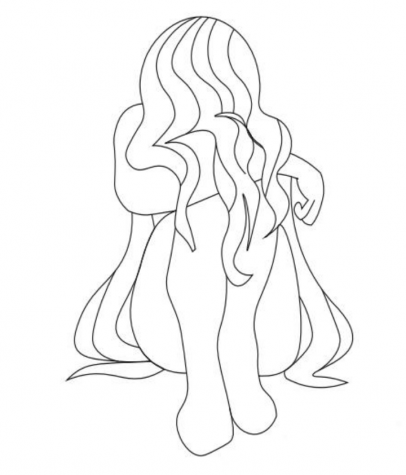Teen abuse remains widely unreported
Domestic abuse theme
Domestic abuse is a widespread problem in the United States, that does not discriminate — according to loveisrespect.org about 1.5 million high school students have experienced abuse in their relationship, and according to childhelp.org, child abuse is reported every 10 seconds.
“If it’s in a relationship it’s going to be termed as domestic violence,” School Resource Officer Michael Anderson said. “That could be anyone who lives under the same house, a dating relationship or a married couple.”
Domestic abuse is when one partner in a relationship is trying to control their partner through either physical or psychological means. When thinking about domestic violence, most people imagine an abusive man beating his partner or spouse, but abuse can be emotionally controlling and present in any relationship regardless of gender.
Student Assistance Counselor Michelle Schwolert, said two out of five students that see her have been abused. This number includes students in abusive relationships and students being abused by parents. Despite the many places for support available, Schwolert said it’s common for people to stay in abusive situations.
“A lot of people would rather deal with [an abusive relationship] than deal with the conflict that comes with trying to get out of it,” Schwolert said.
Many outlets exist to help students out of abuse, such as Texas Department of Family and Protective Services in Lewisville, Denton County Children’s Advocacy Center and local police.
“[We] have to get people involved that can wrap their arms around [the abused] and say ‘we’re here to help you now. It’s not going to be easy but we’re going to get you out of this’,” Schwolert said.
FMPD Detective Joe Adcock, who investigates crimes against children, said 122 cases of domestic abuse were reported in Flower Mound during 2018 alone.
“[Abuse cases] are underreported for adults and that’s probably exponential for juveniles,” Adcock said
.
Adcock said that lack of reporting can stem from economic dependence, threats to revoke custody of children and even self-blame by the abused.
“We can’t do anything about [abuse] if we don’t know about it, so they have to find somebody they trust and they have to tell somebody,” said SRO Anderson.
If the abuser is also a student and there is reason to believe that they will continue to assault the victim, whether by threat or physical injury, the school can implement a non-interaction agreement.This agreement would be signed by both parties and prohibits the abuser from interacting with the abused in a negative way such as unwanted conversation and spreading rumors. If violated, the abuser can be suspended or even expelled.
Teachers and counselors are mandated reporters which means if they become aware of an abusive situation they must report it or suffer legal consequences.
Abuse vs parenting
Anytime someone tries to exert control or dominance over another person, it is abuse. This does not apply the same way to parents. For example, if a parent grounds their child it is not abuse. If a parent spanks their child, it is not abuse because in Texas, parents are allowed to administer some corporal punishment.
While a parent is allowed to physically punish their child, they cannot strike their child without reason because that would be excessive force and could be punished by law. The punishment must be “necessary to discipline the child or to safeguard or promote his welfare,” according to Texas penal code Section 9.61.
“A parent can’t just decide they’ve had a bad day at work they’re going to come home and take it out on their child,” Anderson said.
Recognize abuse in relationships
The first step is becoming educated on abuse and its signs. While most students are not involved in an abusive relationship, knowing the signs can allow them to recognize when others are. Signs of physical abuse include wearing different clothing to cover cuts, scratches or bruises.
“When people think of domestic abuse they think of physically beating, but there’s so much more to domestic abuse, a lot of it is verbal and psychological,” Schwolert said.
Schwolert said signs of emotional abuse include changing their appearance, not talking about the relationship, and a decrease in desire to do other activities.
“[Emotionally] abusive relationships can lead to low self esteem, negative self talk, anxiety, depression, isolation, loneliness, a decrease in grades [and] pulling away from family and friends,” Schwolert said.
Signs of abuse in relationships
-Abusers tend to humiliate, over-criticize, blame and objectify their partners. Victims are often embarrassed if their friends or family see them treated this way.
-Abusive partners can often be violent and threatening. Examples of this include an unpredictable temper, physically hurting the victim, threatening to commit suicide as leverage, destroying belongings and forcing the victim to have sex with them.
-Excessively controlling behavior is a sign of an abusive relationship. Keeping the victim away from their friends and family, extreme jealousy, controlling where their partner goes and limiting access to their phone, car or money are all ways abusers control their partner.
-Even if the abuser has only hurt their victim once, it’s still abuse.
Source: helpguide.org
Reporting abuse
After identifying a situation as abusive, next contact a trusted adult such as police officers, counselors or parents. If it is a physically abusive case, the police can be heavily involved but when it comes to emotional abuse they are able to do less.
“It’s hard for police officers to get involved because we can only enforce things we have evidence on, and we won’t have evidence on mental and emotional abuse,” Anderson said.
In most emotional abuse cases, police will inform Child Protective Services who are trained in handling such cases. They can provide counseling and are trained in how to not jeopardize the case.
If the abuser and the abused are both underage juveniles, the case would be handled in a juvenile court and classified as a misdemeanor. However, in a relationship if the abused is under the age of 14 and the abuser is over the age of 14 or the abused is severely injured, the charge would be upgraded to felony assault.
Physical abuse breaks down into three types. Class C assault is an unwanted touch or assault by threat. If there is an injury, it is a Class A assault. If the injury is serious enough, it would be upgraded to a felony.
“It really depends on a case-by-case basis,” Anderson said. “It’s hard to give a general statement it depends on the circumstances involved.”
Resources to contact
SRO Michael Anderson
469-948-7099
[email protected]
Crisis Counselor Michelle Schwolert
469-948-7003
[email protected]
Denton Children’s Advocacy Center
972-317-2818
Texas Department of Family and Protective Services in Lewisville
972-221-3910
Flower Mound Police Department
972-874-6200

Michael Minton is a senior and this is his second year on staff. He joined the staff after getting to know everyone and falling in love with the amazing...










